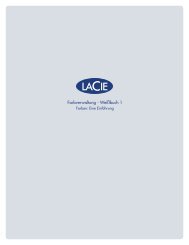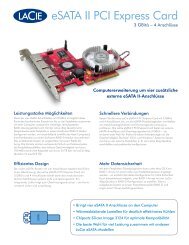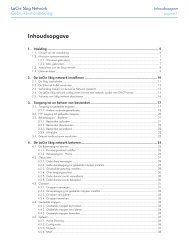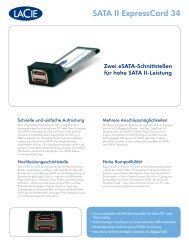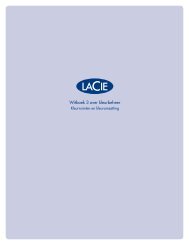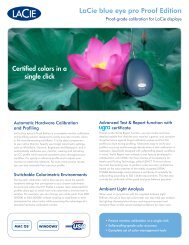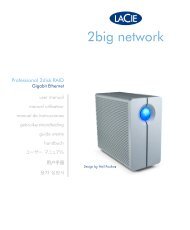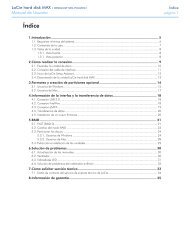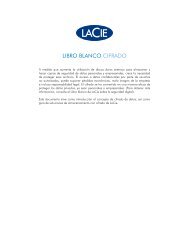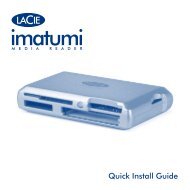Download PDF LaCie D2 Quadra Hard Drive
Download PDF LaCie D2 Quadra Hard Drive
Download PDF LaCie D2 Quadra Hard Drive
Create successful ePaper yourself
Turn your PDF publications into a flip-book with our unique Google optimized e-Paper software.
<strong>LaCie</strong> d2 <strong>Quadra</strong><br />
eSATA Questions & Answers<br />
Quadruple Interface <strong>Hard</strong> <strong>Drive</strong> page<br />
7. eSATA Questions & Answers<br />
■ What is eSATA?<br />
Your <strong>LaCie</strong> d2 <strong>Quadra</strong> <strong>Hard</strong> <strong>Drive</strong> uses the latest<br />
in SATA technology, allowing interface (or bus) transfer<br />
rates of up to 1.5Gb/s. SATA technology was originally<br />
developed to serve as an internal interface, delivering<br />
improved performance to internal connections. Soon<br />
after, eSATA, a connector that can be used for SATA I<br />
as well as SATA II, was developed, allowing for the use<br />
of shielded cables outside the PC.<br />
eSATA technology was developed to be rugged and<br />
durable. eSATA connectors do not have the “L” shaped<br />
design of other SATA connectors. In addition, the guide<br />
features are vertically offset and reduced in size to prevent<br />
the use of unshielded internal cables in external applications.<br />
Initial Serial ATA technology removed the performance<br />
bottleneck of the Parallel ATA specification, and<br />
follows a clearly defined road map to greater and greater<br />
data transfer rates and feature improvements.<br />
Deriving its name from the way that it transmits<br />
signals, in a single stream, or serially, Serial ATA operates<br />
in a point-to-point topology. This connectivity<br />
methodology delivers the entire available interface<br />
bandwidth to each device, allowing each device to operate<br />
at its maximum throughput, and provides direct<br />
communication between the device and the system at<br />
any time, reducing arbitration delays associated with<br />
shared bus topologies.<br />
■<br />
What are the key differences between SATA I<br />
and SATA II technology?<br />
For single drive configurations, SATA I, SATA II<br />
and FireWire 800 will have about the same performance.<br />
However, in a RAID0 configuration, SATA I and SATA<br />
II will allow faster transfer rates than FireWire 800,<br />
which may limit transfer rates.<br />
■<br />
What are the features and benefits of Serial<br />
ATA and Serial ATA II?<br />
The Serial ATA specification provides several key<br />
features that will help spur widespread implementation:<br />
•<br />
•<br />
•<br />
•<br />
•<br />
•<br />
Performance: Serial ATA is a point-to-point topology,<br />
and does not have to share the bus, instead dedicating<br />
full bandwidth to the device. These dedicated<br />
links make creating a Serial ATA RAID array quick<br />
and relatively inexpensive to implement.<br />
Easy installation and configuration: There are no device<br />
IDs, termination or master/slave conflicts, and<br />
the standard supports hot-plug connectivity. <strong>Drive</strong>s<br />
can be added, upgraded or removed without having<br />
to power down the whole system.<br />
Improved reliability: Serial ATA also uses 32-bit cyclic<br />
redundancy checking (CRC) on all transfers to<br />
ensure correct data transmissions. Due to this CRC<br />
capability, Serial ATA performs protection and recovery<br />
features at multiple levels: PHY layer, link<br />
layer and transport and software layers.<br />
Command optimization: Serial ATA utilizes Native<br />
Command Queing (NCQ) and first party direct<br />
memory access (DMA) to intelligently order commands<br />
in an internal queue within the drive, without<br />
having to involve the host CPU. Judging its own<br />
drive head’s angular and rotational position, the drive<br />
selects a data transfer from the queue that will minimize<br />
both its seek and rotational latencies.<br />
Simplified structure: Serial ATA utilizes a more efficient<br />
signaling voltage (250mV vs. 5V for Parallel<br />
ATA), and much smaller, thinner and compact cables<br />
and connectors. Due to the simplified cabling (the<br />
reduction in the number of pins and wires), the number<br />
of fault possibilities decreases.<br />
Seamless integration: Serial ATA maintains register<br />
and software compatibility with Parallel ATA, and




